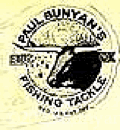

If you don't have a Bunyan Bug in your collection,
then you're missing a very important fly!
In 1923, Norman Edward Means, also known as Paul Bunyan, created a new fly series called the “Bunyan Bugs” for trout fishing in Missoula, Montana. These flies were a hit among Montana fishermen, imitating the large western stoneflies. Interestingly, the Bunyan Bugs series actually includes a wide variety of insects, with around thirty-five different artificial flies at its peak. Some even claim it was one of the first dry flies ever made.
The construction of the Bunyan Bugs is truly unique and unmatched among other Montana or western trout flies. It’s a testament to the ingenuity of its creator. There were once 32 different varieties of Bunyan Bugs. Paul Bunyan was not only a fly-tying pioneer but also a skilled maker of split bamboo fly rods. He deserves recognition and honor for his significant contributions to the sport of fly fishing in the West.
The Bunyan Bugs hold a special place in the history and present of fly fishing. They’ve truly stood the test of time and have caught massive trout and bass on the western rivers of the Rocky Mountains. Paul Bunyan’s grandson, Richard Rose, has been tying Bunyan Bugs for many years and has even modeled them after his grandfather’s originals. These flies are still being made and available to the public.

"Bugs of a Bunyan" Clip


